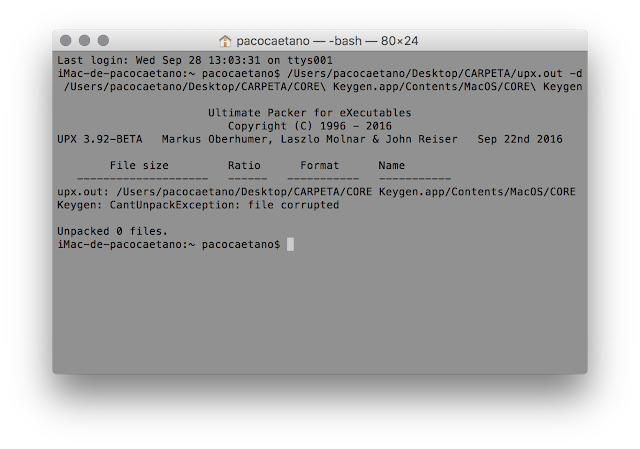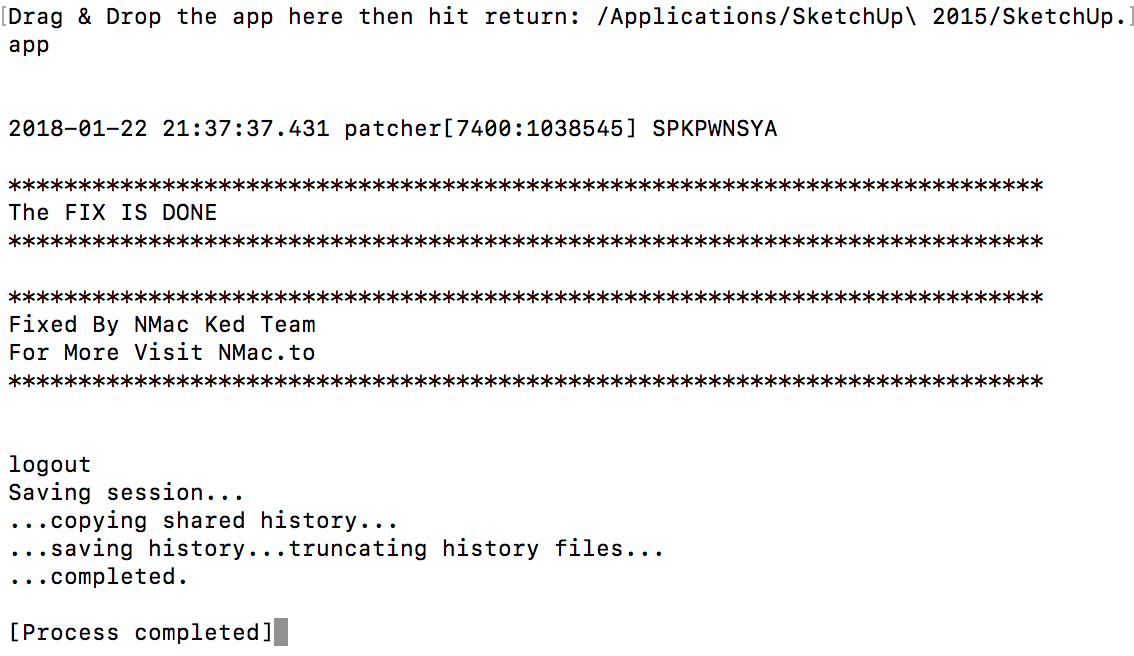On Mac, you may run into the following issue with 'Unidentified Developer' on opening the Installer. Click here for instructions on how to get around this issue. On Windows, you may run into the following issue with missing Java on opening the Installer. This is normal; Java can be downloaded from here. $ upx -f -o date.upx /bin/date 28544 - 17008 59.59% Mach/AMD64 date.upx $ ls -l /bin/date date.upx -rwxr-xr-x 1 root wheel 28544 Sep 6 21:43 /bin/date -rwxr-xr-x 1 jreiser staff 17008 Sep 19 21:16 date.upx $ sum /bin/date date.upx 9372 28 /bin/date 62796 17 date.upx The compressed version also runs after code signing. Audio Hijack Pro can now catch Call Relay audio from FaceTime on OSX 10.10 Yosemite. Simply choose FaceTime and Record! Immediate repairs a number of little problems with sound results gadget handling, On 8.0.3 improves compatibility with the VoiceOver function of Accessibility, and enhances the backend. Mac Blu-ray Player Pro version is the best entertainment choice for the original Blu-ray Menu, Blu-ray Disc, ISO files, and BDMV folder. The Pro version enhances UHD 4K video viewing experience and original audio quality, and improves player performance with better hardware acceleration. It can be fully compatible with the latest Mac OS 10.12. A Mac OS X Framework is a folder whose name ends with '.framework' and contains a Mach-O dynamically linked shared library. For example, 'Test.framework' is a folder, and 'Test.framework/Test' is a dynamic library (note that there's no '.dylib' extension on Framework dylibs, unlike standalone Mac OS.

KLCP gets updated frequently. However, there may be worthwhile updates to some of the included components in between the regular releases of KLCP. The update pack below can be used to keep your current installation up-to-date.
This update pack is suppossed to be installed on top of the latest version of the codec pack. The minimum required version of your currently installed codec pack is mentioned below. The update pack is cumulative, meaning it contains all changes since that version. You do not need to install any versions in between.
version 15.9.3 ~ 18.4 MB ~ December 11th 2020

Update for:
K-Lite Codec Pack 15.9.0 and newer (Basic/Standard/Full/Mega)
Changelog:
- Updated MPC-HC to version 1.9.8.78
- Updated LAV Filters to version 0.74.1-92-g88da5
- Updated MPC Video Renderer to version 0.4.10.1514
| Type: | Download Location: | Hosted By: |
| HTTP | Server 1 | Codec Guide |
| HTTPS | Server 2 | Codec Guide |
| HTTP | Server 3 (external) | majorgeeks.com |
Filename: klcp_update_1593_20201211.exe
Size: 18855 KB
MD5: 5d439a84115106cbc15633c910d88775
SHA256: 3592d994ccf362652f8749eafe72c874a8f7c1da7bae18d8eec97c94faa2b66b
Complete installer
You can download the normal installer of codec pack HERE. Also check out our beta version page HERE, where you can often find installers that already include the latest updates.
Windows XP
This version does not support Windows XP anymore. The last version of the codec pack that works on XP is 13.8.5.
Updating older versions
The update pack contains all cumulative changes since the last major release of the codec pack. The minimum required version of your current codec pack installation is mentioned above.
If your current installation is a version older than required by this update pack, then you need to download the latest version of the regular installer HERE. Once that is installed, you can install the update above (if it is a newer version).
The regular installers can be used to update any version of the codec pack. You can simply install on top of your current installation. The installer will automatically notify you if it is needed to uninstall an old version first, and offers to do that automatically.
Detailed changes
Are you curious what exactly has changed in for example MPC-HC and LAV Filters? Take a look HERE.
 -->
-->Looking to install a package? See Ways to install NuGet packages.
To work with NuGet, as a package consumer or creator, you can use command-line interface (CLI) tools as well as NuGet features in Visual Studio. This article briefly outlines the capabilities of the different tools, how to install them, and their comparative feature availability. To get started using NuGet to consume packages, see Install and use a package (dotnet CLI) and Install and use a package (Visual Studio). To get started creating NuGet packages, see Create and publish a NET Standard package (dotnet CLI) and Create and publish a NET Standard package (Visual Studio).
| Tool | Description | Download |
|---|---|---|
| dotnet.exe | CLI tool for .NET Core and .NET Standard libraries, and for any SDK-style project such as one that targets .NET Framework. Included with the .NET Core SDK and provides core NuGet features on all platforms. (Starting in Visual Studio 2017, the dotnet CLI is automatically installed with any .NET Core related workloads.) | .NET Core SDK |
| nuget.exe | CLI tool for .NET Framework libraries and for any non-SDK-style project such as one that targets .NET Standard libraries. Provides all NuGet capabilities on Windows, provides most features on Mac and Linux when running under Mono. | nuget.exe |
| Visual Studio | On Windows, the NuGet Package Manager is included with Visual Studio 2012 and later. Visual Studio provides the Package Manager UI and the Package Manager Console, through which you can run most NuGet operations. | Visual Studio |
| Visual Studio for Mac | On Mac, certain NuGet capabilities are built-in directly. Package Manager Console is not presently available. For other capabilities, use the dotnet.exe or nuget.exe CLI tools. | Visual Studio for Mac |
| Visual Studio Code | On Windows, Mac, or Linux, NuGet capabilities are available through marketplace extensions, or use the dotnet.exe or nuget.exe CLI tools. | Visual Studio Code |
The MSBuild CLI also provides the ability to restore and create packages, which is primarily useful on build servers. MSBuild is not a general-purpose tool for working with NuGet.
Package Manager Console commands work only within Visual Studio on Windows and do not work within other PowerShell environments.
Visual Studio
Install on Visual Studio 2017 and newer
Starting in Visual Studio 2017, the installer includes the NuGet Package Manager with any workload that employs .NET. To install separately, or to verify that the Package Manager is installed, run the Visual Studio installer and check the option under Individual Components > Code tools > NuGet package manager.
Install on Visual Studio 2015 and older
NuGet Extensions for Visual Studio 2013 and 2015 can be downloaded from https://dist.nuget.org/index.html.
For Visual Studio 2010 and earlier, install the 'NuGet Package Manager for Visual Studio' extension. Note, if you can't see the extension in the first page of search results, try changing the Sort By dropdown to 'Most Downloads', or an alphabetical sort.
CLI tools
You can use either the dotnet CLI or the nuget.exe CLI to support NuGet features in the IDE. The dotnet CLI is installed with some Visual Studio workloads, such as .NET Core. The nuget.exe CLI must be installed separately as described earlier.
The two NuGet CLI tools are dotnet.exe and nuget.exe. See feature availability for a comparison.
- To target .NET Core or .NET Standard, use the dotnet CLI. The
dotnetCLI is required for the SDK-style project format, which uses the SDK attribute. - To target .NET Framework (non-SDK-style project only), use the
nuget.exeCLI. If the project is migrated frompackages.configto PackageReference, use the dotnet CLI.
dotnet.exe CLI
The .NET Core 2.0 CLI, dotnet.exe, works on all platforms (Windows, Mac, and Linux) and provides core NuGet features such as installing, restoring, and publishing packages. dotnet provides direct integration with .NET Core project files (such as .csproj), which is helpful in most scenarios. dotnet is also built directly for each platform and does not require you to install Mono.
Installation:
- On developer computers, install the .NET Core SDK. Starting in Visual Studio 2017, the dotnet CLI is automatically installed with any .NET Core related workloads.
- For build servers, follow the instructions on Using .NET Core SDK and tools in Continuous Integration.
To learn how to use basic commands with the dotnet CLI, see Install and use packages using the dotnet CLI.
nuget.exe CLI
The nuget.exe CLI, nuget.exe, is the command-line utility for Windows that provides all NuGet capabilities; it can also be run on Mac OSX and Linux using Mono with some limitations.
To learn how to use basic commands with the nuget.exe CLI, see Install and use packages using the nuget.exe CLI.
Installation:
Windows

Note
NuGet.exe 5.0 and later require .NET Framework 4.7.2 or later to execute.
- Visit nuget.org/downloads and select NuGet 3.3 or higher (2.8.6 is not compatible with Mono). The latest version is always recommended, and 4.1.0+ is required to publish packages to nuget.org.
- Each download is the
nuget.exefile directly. Instruct your browser to save the file to a folder of your choice. The file is not an installer; you won't see anything if you run it directly from the browser. - Add the folder where you placed
nuget.exeto your PATH environment variable to use the CLI tool from anywhere.
macOS/Linux
Behaviors may vary slightly by OS distribution.
Install Mono 4.4.2 or later.
Execute the following command at a shell prompt:
Create an alias by adding the following script to the appropriate file for your OS (typically
~/.bash_aliasesor~/.bash_profile):Reload the shell. Test the installation by entering
nugetwith no parameters. NuGet CLI help should display.
Tip
Use nuget update -self on Windows to update an existing nuget.exe to the latest version.
Note
The latest recommended NuGet CLI is always available at https://dist.nuget.org/win-x86-commandline/latest/nuget.exe. For compatibility purposes with older continuous integration systems, a previous URL, https://nuget.org/nuget.exe currently provides the deprecated 2.8.6 CLI tool.
Fix Core Kg K Patcher Upx Problem For Mac 7
Feature availability
| Feature | dotnet CLI | nuget CLI (Windows) | nuget CLI (Mono) | Visual Studio (Windows) | Visual Studio for Mac |
|---|---|---|---|---|---|
| Search packages | ✔ | ✔ | ✔ | ✔ | |
| Install/uninstall packages | ✔ | ✔(1) | ✔ | ✔ | ✔ |
| Update packages | ✔ | ✔ | ✔ | ✔ | |
| Restore packages | ✔ | ✔ | ✔(2) | ✔ | ✔ |
| Manage package feeds (sources) | ✔ | ✔ | ✔ | ✔ | |
| Manage packages on a feed | ✔ | ✔ | ✔ | ||
| Set API keys for feeds | ✔ | ✔ | |||
| Create packages(3) | ✔ | ✔ | ✔(4) | ✔ | |
| Publish packages | ✔ | ✔ | ✔ | ✔ | |
| Replicate packages | ✔ | ✔ | |||
| Manage global-package and cache folders | ✔ | ✔ | ✔ | ||
| Manage NuGet configuration | ✔ | ✔ |
(1) Does not affect project files; use dotnet.exe instead.
(2) Works only with packages.config file and not with solution (.sln) files.
(3) Various advanced package features are available through the CLI only as they aren't represented in the Visual Studio UI tools.
How To Fix Core Kg & K Patcher Upx Problem For Macos High Sierra

(4) Works with .nuspec files but not with project files.
Upcoming Features
If you'd like to preview upcoming NuGet features, install a Visual Studio Preview, which works side-by-side with stable releases of Visual Studio. To report problems or share ideas for previews, open an issue on the NuGet GitHub repository.
Related topics
Fix Core Kg & K Patcher Upx Problem For Mac Os Mojave
Developers working on Windows can also explore the NuGet Package Explorer, an open-source, stand-alone tool to visually explore, create, and edit NuGet packages. It's very helpful, for example, to make experimental changes to a package structure without rebuilding the package.
